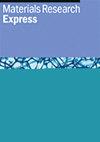相对分子取向会影响分子晶体塑性的开始
IF 2.2
4区 材料科学
Q3 MATERIALS SCIENCE, MULTIDISCIPLINARY
引用次数: 0
摘要
产生或移动位错是在接触载荷下通过塑性变形耗散机械能的第一步。在分子晶体中,既有定义晶体取向的晶格,也有分子基础的相对取向。我们定义了一个归一化参数,它将屈服时的应变、块状晶体的硬度和一个类似于布尔格斯矢量的距离参数联系起来,名义上预测了这一大类材料开始塑性的相对难易程度。对 10 种不同空间群的分子晶体的屈服行为进行分析后发现,分子间取向可预测实验观察到的位错成核所需的外加应力。当分子相对于彼此 "平行 "取向时,塑性开始时的归一化最大剪切应力比晶体内分子 "反平行 "时低 3-5 倍,而形状更加等轴的分子则介于这两个界限之间。这初步表明了一种结构特征,它可以预测分子晶体在接触加载过程中启动塑性的相对难易程度。本文章由计算机程序翻译,如有差异,请以英文原文为准。
Relative molecular orientation can impact the onset of plasticity in molecular crystals
Creating or moving dislocations is the first step to dissipating mechanical energy via plastic deformation under contact loading. In molecular crystals there is both a lattice that defines crystal orientation and a relative orientation of the basis of the molecules. We define a normalization parameter which relates strain at yield, the hardness of the bulk crystal, and a distance parameter analogous to a Burgers vector that nominally predicts the relative ease of initiating plasticity in this broad class of materials. Analyzing the yield behavior of 10 different molecular crystals of varying space groups shows the inter-molecular orientation predicts the experimentally observed applied stress needed to nucleate dislocations. When molecules are oriented ‘parallel’ relative to one another the normalized maximum shear stress at the onset of plasticity is on the order of 3–5 times lower than when molecules within the crystal are ‘anti-parallel’, and molecules with a more equiaxed shape fall in between these bounds. This provides an initial indication of a structural feature which predicts the relative ease of initiating plasticity during contact loading in molecular crystals.
求助全文
通过发布文献求助,成功后即可免费获取论文全文。
去求助
来源期刊

Materials Research Express
MATERIALS SCIENCE, MULTIDISCIPLINARY-
CiteScore
4.50
自引率
4.30%
发文量
640
审稿时长
12 weeks
期刊介绍:
A broad, rapid peer-review journal publishing new experimental and theoretical research on the design, fabrication, properties and applications of all classes of materials.
 求助内容:
求助内容: 应助结果提醒方式:
应助结果提醒方式:


